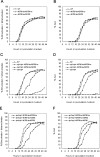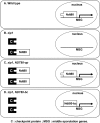Nuclear localization of the meiosis-specific transcription factor Ndt80 is regulated by the pachytene checkpoint
- PMID: 21471004
- PMCID: PMC3103403
- DOI: 10.1091/mbc.E10-12-1011
Nuclear localization of the meiosis-specific transcription factor Ndt80 is regulated by the pachytene checkpoint
Abstract
In budding yeast, the Ndt80 protein is a meiosis-specific transcription factor that is essential for the exit of pachytene and progression into nuclear divisions and spore formation. The pachytene checkpoint responds to defects in meiotic recombination and chromosome synapsis and negatively regulates the activity of Ndt80. The activity of Ndt80 was suggested to be regulated at both transcriptional and posttranslational levels; however, the mechanism for posttranslational regulation of Ndt80 was unclear. From a study of ndt80 in-frame deletion mutations, we have identified a dominant mutation NDT80-bc, which is able to completely bypass the pachytene checkpoint. The NDT80-bc mutation relieves the checkpoint-mediated arrest of the zip1, dmc1, and hop2 mutants, producing spores with low viability. The NDT80-bc mutant provides direct evidence for the posttranslational control of Ndt80 activity. Furthermore, the data presented show that Ndt80 is retained in cytoplasm in the zip1 mutant, whereas Ndt80-bc is found in the nucleus. We propose that the nuclear localization of Ndt80 is regulated by the pachytene checkpoint through a cytoplasmic anchor mechanism.
Figures





Similar articles
-
The Sum1/Ndt80 transcriptional switch and commitment to meiosis in Saccharomyces cerevisiae.Microbiol Mol Biol Rev. 2012 Mar;76(1):1-15. doi: 10.1128/MMBR.05010-11. Microbiol Mol Biol Rev. 2012. PMID: 22390969 Free PMC article. Review.
-
Role of Ndt80, Sum1, and Swe1 as targets of the meiotic recombination checkpoint that control exit from pachytene and spore formation in Saccharomyces cerevisiae.Mol Cell Biol. 2002 Sep;22(18):6430-40. doi: 10.1128/MCB.22.18.6430-6440.2002. Mol Cell Biol. 2002. PMID: 12192042 Free PMC article.
-
The pachytene checkpoint prevents accumulation and phosphorylation of the meiosis-specific transcription factor Ndt80.Proc Natl Acad Sci U S A. 2000 Oct 24;97(22):12187-92. doi: 10.1073/pnas.220464597. Proc Natl Acad Sci U S A. 2000. PMID: 11035815 Free PMC article.
-
Mek1 coordinates meiotic progression with DNA break repair by directly phosphorylating and inhibiting the yeast pachytene exit regulator Ndt80.PLoS Genet. 2018 Nov 29;14(11):e1007832. doi: 10.1371/journal.pgen.1007832. eCollection 2018 Nov. PLoS Genet. 2018. PMID: 30496175 Free PMC article.
-
Deconstructing meiosis one kinase at a time: polo pushes past pachytene.Genes Dev. 2008 Oct 1;22(19):2596-600. doi: 10.1101/gad.1727508. Genes Dev. 2008. PMID: 18832063 Free PMC article. Review.
Cited by
-
Functional Impact of the H2A.Z Histone Variant During Meiosis in Saccharomyces cerevisiae.Genetics. 2018 Aug;209(4):997-1015. doi: 10.1534/genetics.118.301110. Epub 2018 May 31. Genetics. 2018. PMID: 29853474 Free PMC article.
-
The budding yeast polo-like kinase Cdc5 regulates the Ndt80 branch of the meiotic recombination checkpoint pathway.Mol Biol Cell. 2011 Sep;22(18):3478-90. doi: 10.1091/mbc.E11-06-0482. Epub 2011 Jul 27. Mol Biol Cell. 2011. PMID: 21795394 Free PMC article.
-
Extreme Diversity in the Regulation of Ndt80-Like Transcription Factors in Fungi.G3 (Bethesda). 2015 Oct 23;5(12):2783-92. doi: 10.1534/g3.115.021378. G3 (Bethesda). 2015. PMID: 26497142 Free PMC article.
-
Meiosis in budding yeast.Genetics. 2023 Oct 4;225(2):iyad125. doi: 10.1093/genetics/iyad125. Genetics. 2023. PMID: 37616582 Free PMC article.
-
The Sum1/Ndt80 transcriptional switch and commitment to meiosis in Saccharomyces cerevisiae.Microbiol Mol Biol Rev. 2012 Mar;76(1):1-15. doi: 10.1128/MMBR.05010-11. Microbiol Mol Biol Rev. 2012. PMID: 22390969 Free PMC article. Review.
References
-
- Baeuerle P, Baltimore D. IκB: a specific inhibitor of the NFκB transcription factor. Science. 1988;242:540–546. - PubMed
-
- Bishop DK, Park D, Xu L, Kleckner N. DMC1: a meiosis-specific yeast homolog of E. coli recA required for recombination, synaptonemal complex formation, and cell cycle progression. Cell. 1992;69:439–456. - PubMed
Publication types
MeSH terms
Substances
LinkOut - more resources
Full Text Sources
Other Literature Sources
Molecular Biology Databases

